Sustainable Toilet Solutions Report
VerifiedAdded on 2019/10/30
|16
|3655
|162
Report
AI Summary
This report, submitted as part of a course at University name, explores sustainable toilet solutions to address the global sanitation crisis. It focuses on the work of WISO, an organization aiming to improve sanitation for 100 million Indians by 2019. The report details four key WISO products: the Safe Toilet (SATO), the Micro Flush Toilet System, the Green Toilet System (converting waste into fertilizer), and the Portable Toilet System for slum areas. Each solution is described, highlighting its features, benefits, and target audience. The report also includes a section on forest management organizations in China, India, Indonesia, and Pakistan, seemingly unrelated to the main focus on sanitation. The overall aim is to present community-driven, economically sustainable, and financially viable solutions to improve sanitation globally.
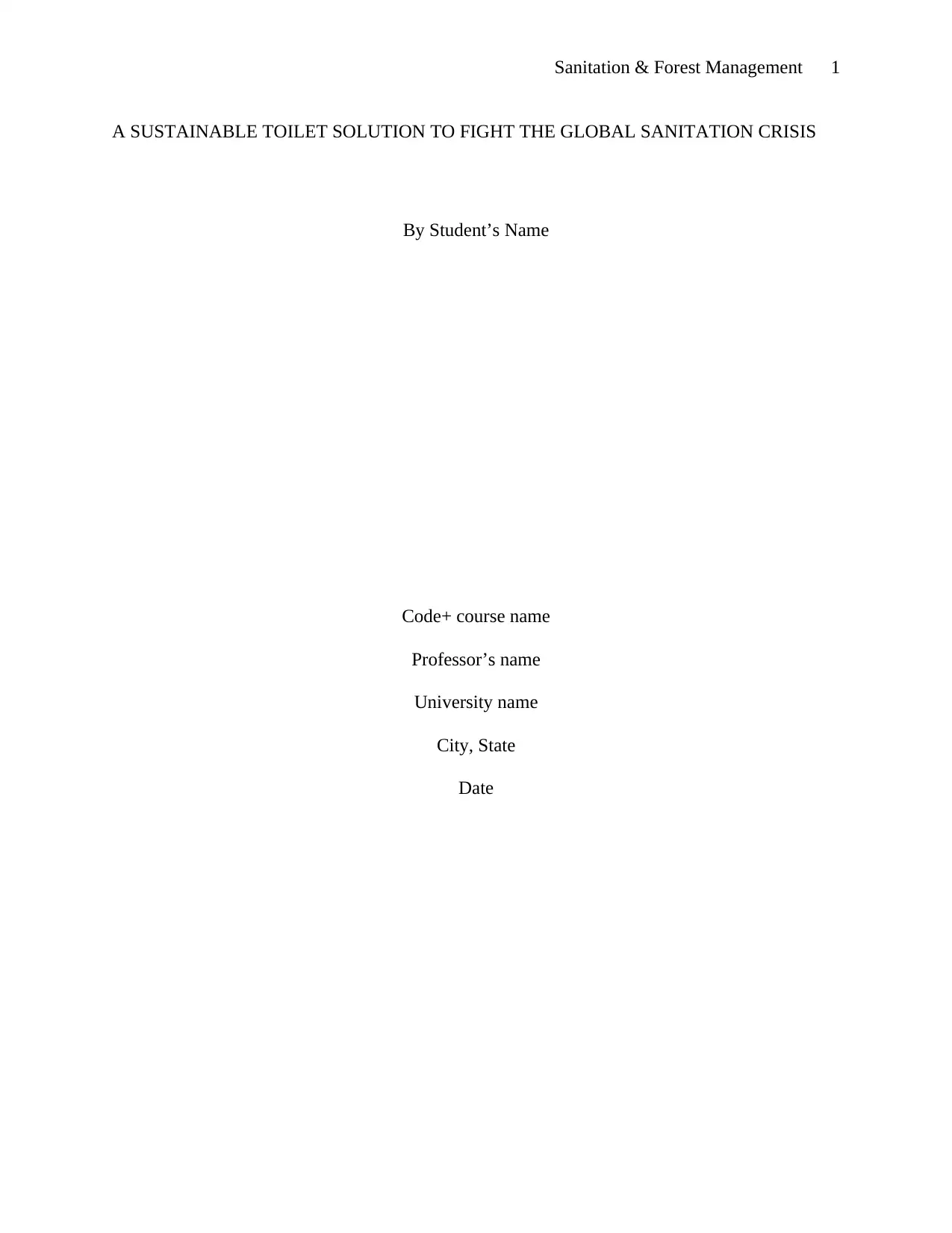
Sanitation & Forest Management 1
A SUSTAINABLE TOILET SOLUTION TO FIGHT THE GLOBAL SANITATION CRISIS
By Student’s Name
Code+ course name
Professor’s name
University name
City, State
Date
A SUSTAINABLE TOILET SOLUTION TO FIGHT THE GLOBAL SANITATION CRISIS
By Student’s Name
Code+ course name
Professor’s name
University name
City, State
Date
Paraphrase This Document
Need a fresh take? Get an instant paraphrase of this document with our AI Paraphraser
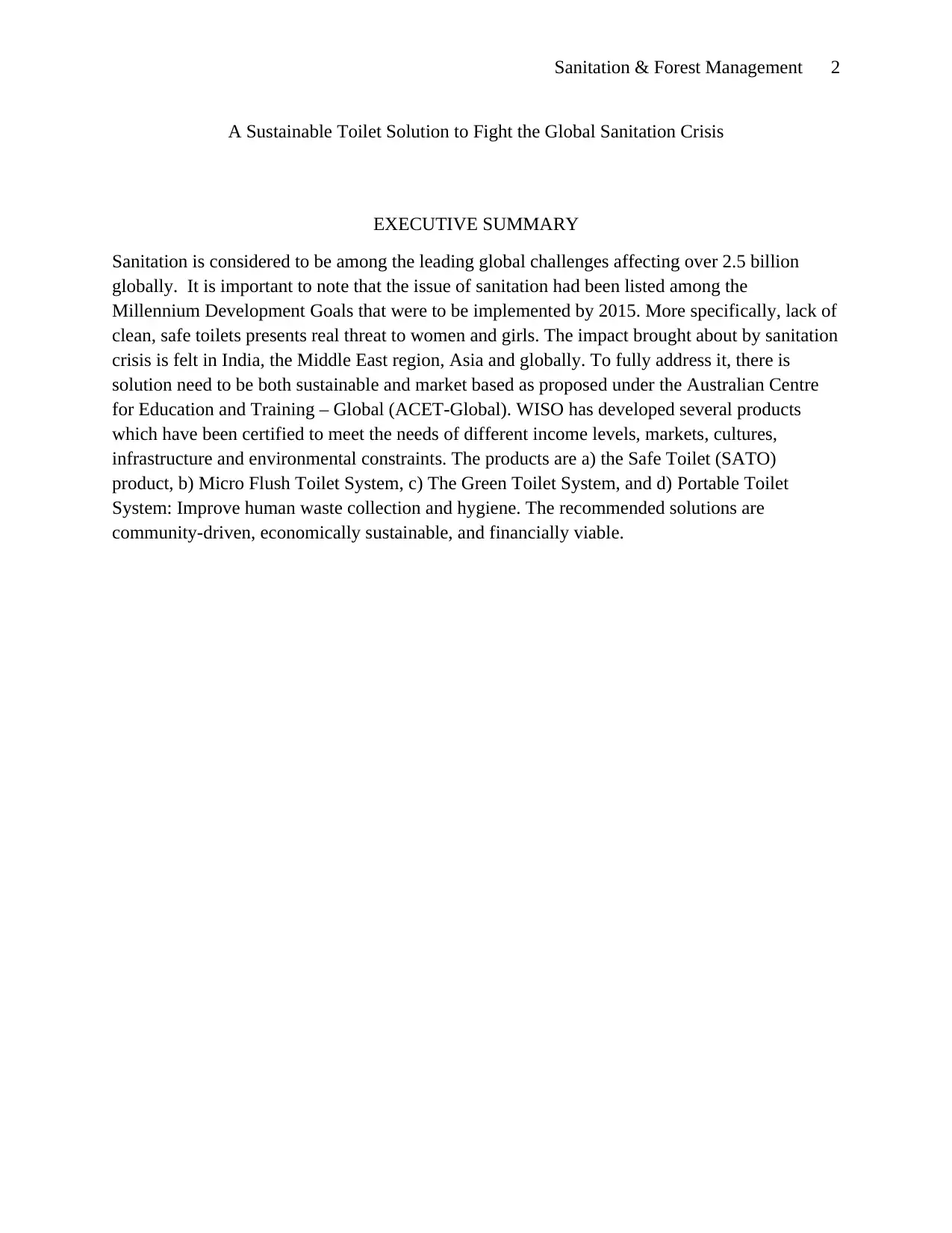
Sanitation & Forest Management 2
A Sustainable Toilet Solution to Fight the Global Sanitation Crisis
EXECUTIVE SUMMARY
Sanitation is considered to be among the leading global challenges affecting over 2.5 billion
globally. It is important to note that the issue of sanitation had been listed among the
Millennium Development Goals that were to be implemented by 2015. More specifically, lack of
clean, safe toilets presents real threat to women and girls. The impact brought about by sanitation
crisis is felt in India, the Middle East region, Asia and globally. To fully address it, there is
solution need to be both sustainable and market based as proposed under the Australian Centre
for Education and Training – Global (ACET-Global). WISO has developed several products
which have been certified to meet the needs of different income levels, markets, cultures,
infrastructure and environmental constraints. The products are a) the Safe Toilet (SATO)
product, b) Micro Flush Toilet System, c) The Green Toilet System, and d) Portable Toilet
System: Improve human waste collection and hygiene. The recommended solutions are
community-driven, economically sustainable, and financially viable.
A Sustainable Toilet Solution to Fight the Global Sanitation Crisis
EXECUTIVE SUMMARY
Sanitation is considered to be among the leading global challenges affecting over 2.5 billion
globally. It is important to note that the issue of sanitation had been listed among the
Millennium Development Goals that were to be implemented by 2015. More specifically, lack of
clean, safe toilets presents real threat to women and girls. The impact brought about by sanitation
crisis is felt in India, the Middle East region, Asia and globally. To fully address it, there is
solution need to be both sustainable and market based as proposed under the Australian Centre
for Education and Training – Global (ACET-Global). WISO has developed several products
which have been certified to meet the needs of different income levels, markets, cultures,
infrastructure and environmental constraints. The products are a) the Safe Toilet (SATO)
product, b) Micro Flush Toilet System, c) The Green Toilet System, and d) Portable Toilet
System: Improve human waste collection and hygiene. The recommended solutions are
community-driven, economically sustainable, and financially viable.
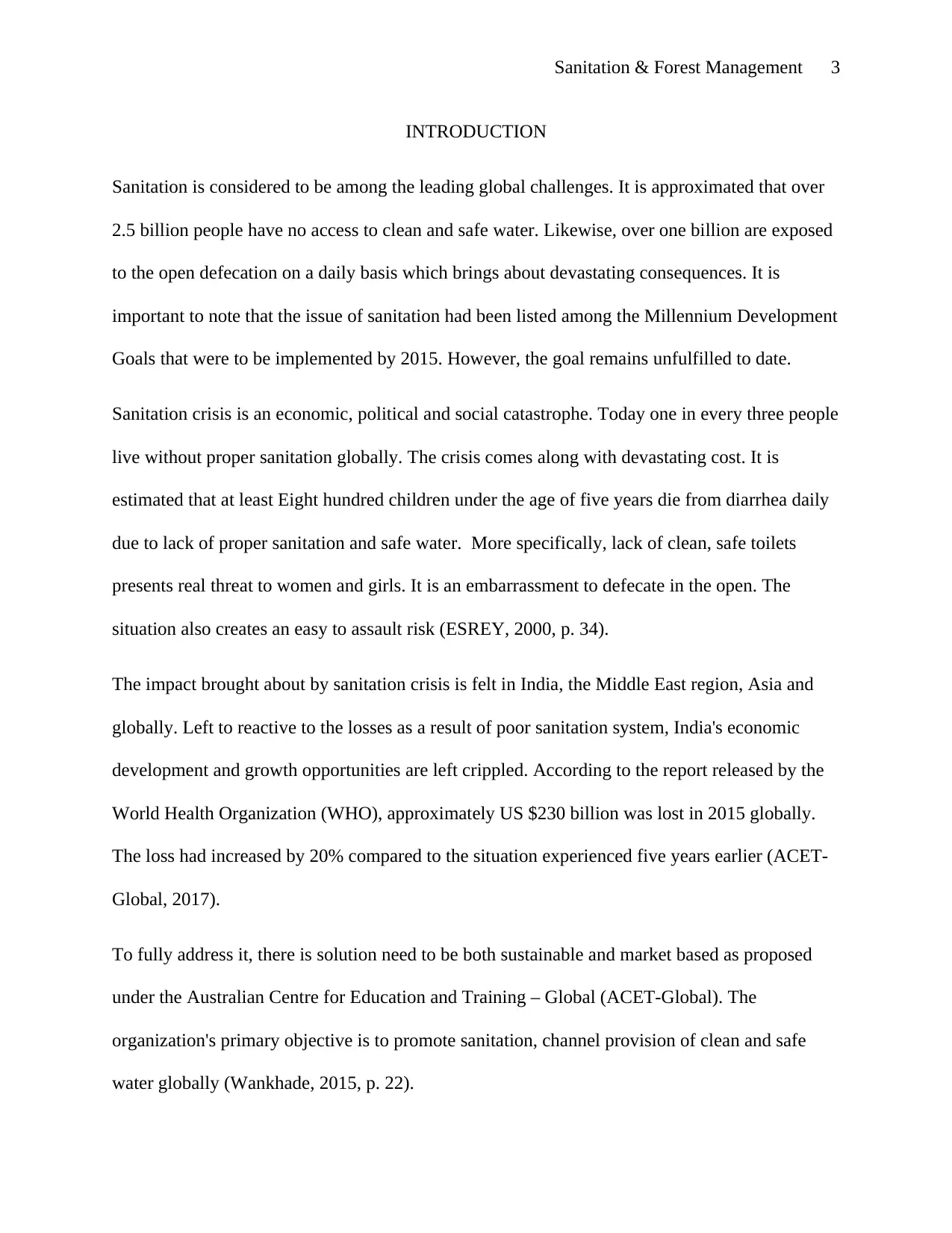
Sanitation & Forest Management 3
INTRODUCTION
Sanitation is considered to be among the leading global challenges. It is approximated that over
2.5 billion people have no access to clean and safe water. Likewise, over one billion are exposed
to the open defecation on a daily basis which brings about devastating consequences. It is
important to note that the issue of sanitation had been listed among the Millennium Development
Goals that were to be implemented by 2015. However, the goal remains unfulfilled to date.
Sanitation crisis is an economic, political and social catastrophe. Today one in every three people
live without proper sanitation globally. The crisis comes along with devastating cost. It is
estimated that at least Eight hundred children under the age of five years die from diarrhea daily
due to lack of proper sanitation and safe water. More specifically, lack of clean, safe toilets
presents real threat to women and girls. It is an embarrassment to defecate in the open. The
situation also creates an easy to assault risk (ESREY, 2000, p. 34).
The impact brought about by sanitation crisis is felt in India, the Middle East region, Asia and
globally. Left to reactive to the losses as a result of poor sanitation system, India's economic
development and growth opportunities are left crippled. According to the report released by the
World Health Organization (WHO), approximately US $230 billion was lost in 2015 globally.
The loss had increased by 20% compared to the situation experienced five years earlier (ACET-
Global, 2017).
To fully address it, there is solution need to be both sustainable and market based as proposed
under the Australian Centre for Education and Training – Global (ACET-Global). The
organization's primary objective is to promote sanitation, channel provision of clean and safe
water globally (Wankhade, 2015, p. 22).
INTRODUCTION
Sanitation is considered to be among the leading global challenges. It is approximated that over
2.5 billion people have no access to clean and safe water. Likewise, over one billion are exposed
to the open defecation on a daily basis which brings about devastating consequences. It is
important to note that the issue of sanitation had been listed among the Millennium Development
Goals that were to be implemented by 2015. However, the goal remains unfulfilled to date.
Sanitation crisis is an economic, political and social catastrophe. Today one in every three people
live without proper sanitation globally. The crisis comes along with devastating cost. It is
estimated that at least Eight hundred children under the age of five years die from diarrhea daily
due to lack of proper sanitation and safe water. More specifically, lack of clean, safe toilets
presents real threat to women and girls. It is an embarrassment to defecate in the open. The
situation also creates an easy to assault risk (ESREY, 2000, p. 34).
The impact brought about by sanitation crisis is felt in India, the Middle East region, Asia and
globally. Left to reactive to the losses as a result of poor sanitation system, India's economic
development and growth opportunities are left crippled. According to the report released by the
World Health Organization (WHO), approximately US $230 billion was lost in 2015 globally.
The loss had increased by 20% compared to the situation experienced five years earlier (ACET-
Global, 2017).
To fully address it, there is solution need to be both sustainable and market based as proposed
under the Australian Centre for Education and Training – Global (ACET-Global). The
organization's primary objective is to promote sanitation, channel provision of clean and safe
water globally (Wankhade, 2015, p. 22).
⊘ This is a preview!⊘
Do you want full access?
Subscribe today to unlock all pages.

Trusted by 1+ million students worldwide
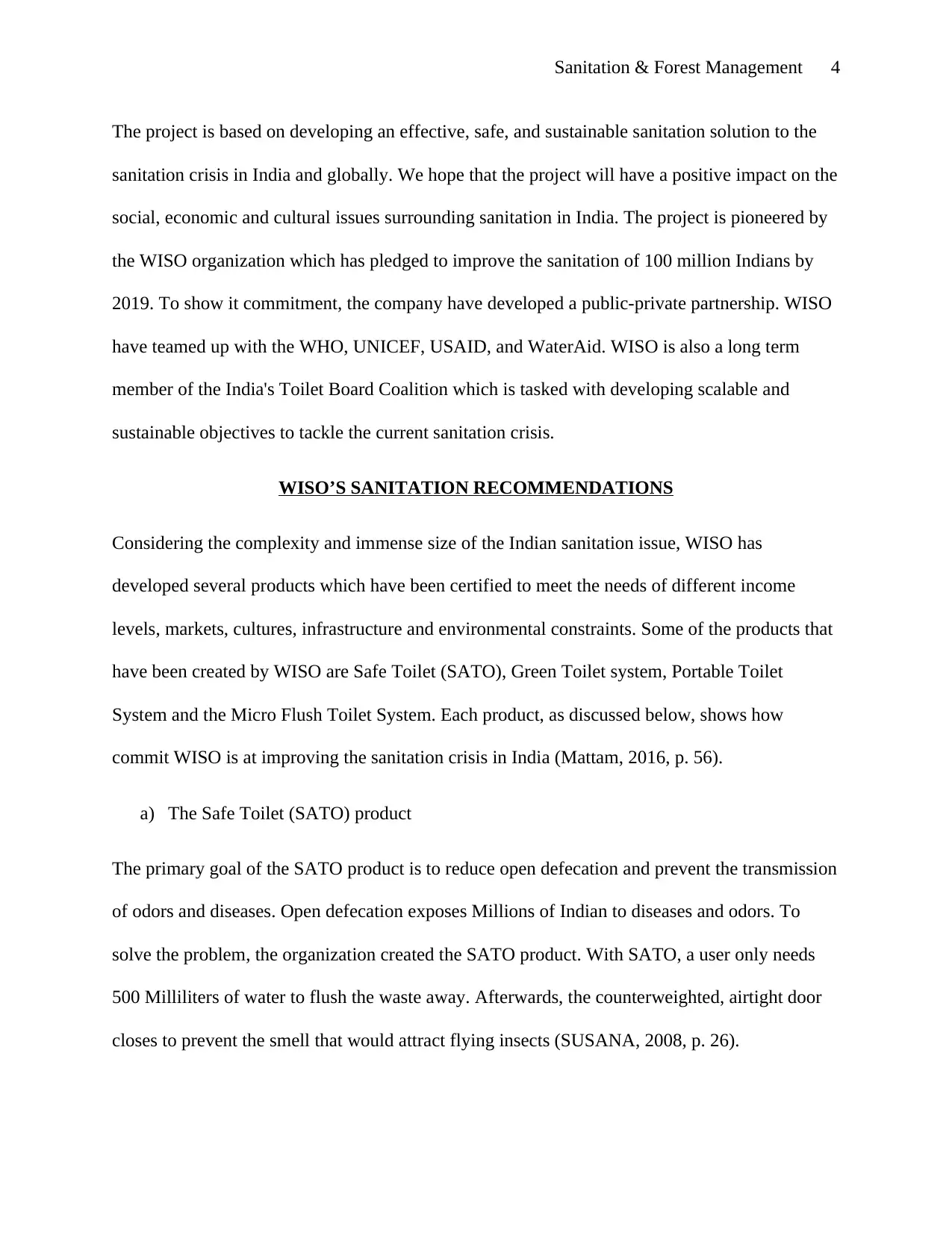
Sanitation & Forest Management 4
The project is based on developing an effective, safe, and sustainable sanitation solution to the
sanitation crisis in India and globally. We hope that the project will have a positive impact on the
social, economic and cultural issues surrounding sanitation in India. The project is pioneered by
the WISO organization which has pledged to improve the sanitation of 100 million Indians by
2019. To show it commitment, the company have developed a public-private partnership. WISO
have teamed up with the WHO, UNICEF, USAID, and WaterAid. WISO is also a long term
member of the India's Toilet Board Coalition which is tasked with developing scalable and
sustainable objectives to tackle the current sanitation crisis.
WISO’S SANITATION RECOMMENDATIONS
Considering the complexity and immense size of the Indian sanitation issue, WISO has
developed several products which have been certified to meet the needs of different income
levels, markets, cultures, infrastructure and environmental constraints. Some of the products that
have been created by WISO are Safe Toilet (SATO), Green Toilet system, Portable Toilet
System and the Micro Flush Toilet System. Each product, as discussed below, shows how
commit WISO is at improving the sanitation crisis in India (Mattam, 2016, p. 56).
a) The Safe Toilet (SATO) product
The primary goal of the SATO product is to reduce open defecation and prevent the transmission
of odors and diseases. Open defecation exposes Millions of Indian to diseases and odors. To
solve the problem, the organization created the SATO product. With SATO, a user only needs
500 Milliliters of water to flush the waste away. Afterwards, the counterweighted, airtight door
closes to prevent the smell that would attract flying insects (SUSANA, 2008, p. 26).
The project is based on developing an effective, safe, and sustainable sanitation solution to the
sanitation crisis in India and globally. We hope that the project will have a positive impact on the
social, economic and cultural issues surrounding sanitation in India. The project is pioneered by
the WISO organization which has pledged to improve the sanitation of 100 million Indians by
2019. To show it commitment, the company have developed a public-private partnership. WISO
have teamed up with the WHO, UNICEF, USAID, and WaterAid. WISO is also a long term
member of the India's Toilet Board Coalition which is tasked with developing scalable and
sustainable objectives to tackle the current sanitation crisis.
WISO’S SANITATION RECOMMENDATIONS
Considering the complexity and immense size of the Indian sanitation issue, WISO has
developed several products which have been certified to meet the needs of different income
levels, markets, cultures, infrastructure and environmental constraints. Some of the products that
have been created by WISO are Safe Toilet (SATO), Green Toilet system, Portable Toilet
System and the Micro Flush Toilet System. Each product, as discussed below, shows how
commit WISO is at improving the sanitation crisis in India (Mattam, 2016, p. 56).
a) The Safe Toilet (SATO) product
The primary goal of the SATO product is to reduce open defecation and prevent the transmission
of odors and diseases. Open defecation exposes Millions of Indian to diseases and odors. To
solve the problem, the organization created the SATO product. With SATO, a user only needs
500 Milliliters of water to flush the waste away. Afterwards, the counterweighted, airtight door
closes to prevent the smell that would attract flying insects (SUSANA, 2008, p. 26).
Paraphrase This Document
Need a fresh take? Get an instant paraphrase of this document with our AI Paraphraser
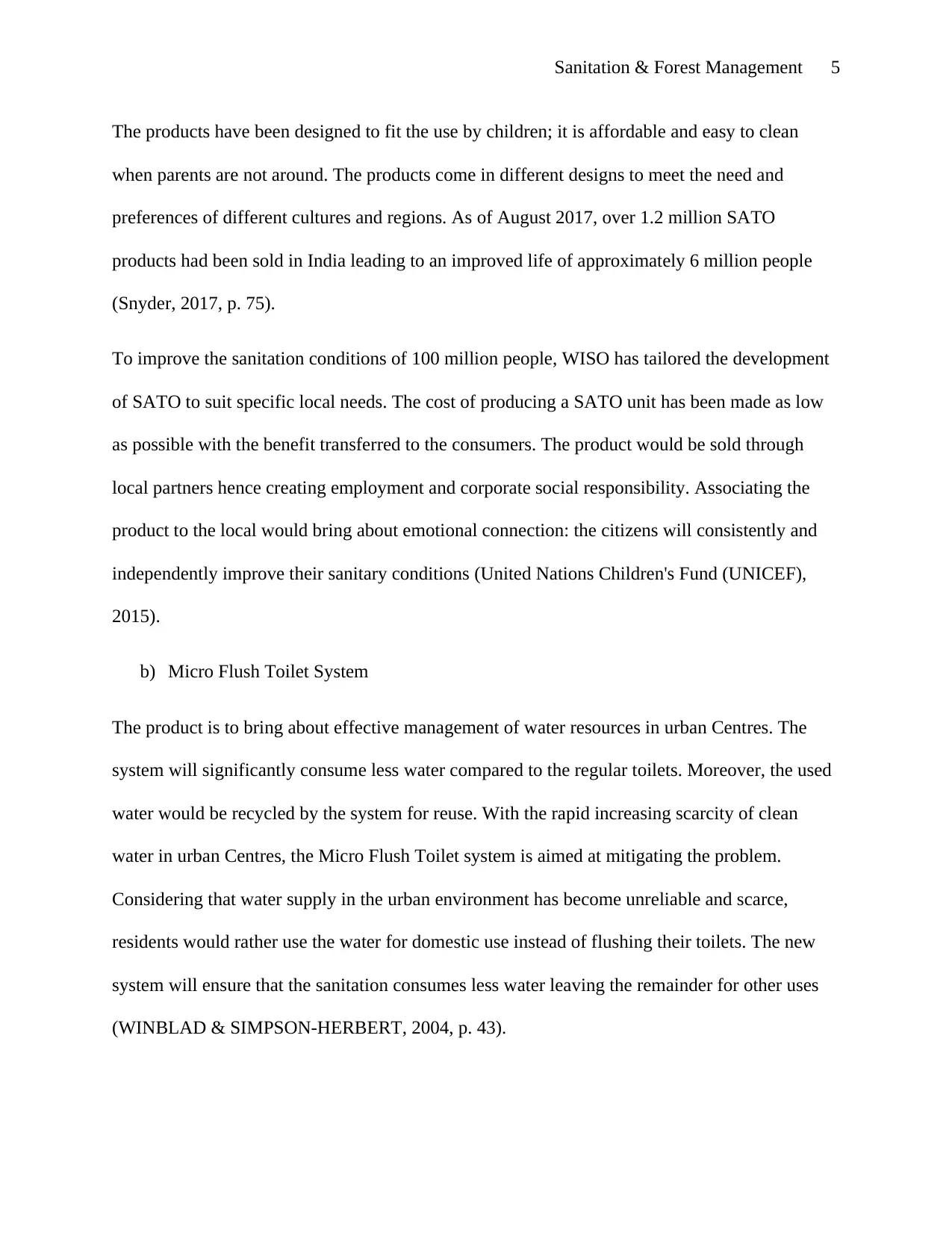
Sanitation & Forest Management 5
The products have been designed to fit the use by children; it is affordable and easy to clean
when parents are not around. The products come in different designs to meet the need and
preferences of different cultures and regions. As of August 2017, over 1.2 million SATO
products had been sold in India leading to an improved life of approximately 6 million people
(Snyder, 2017, p. 75).
To improve the sanitation conditions of 100 million people, WISO has tailored the development
of SATO to suit specific local needs. The cost of producing a SATO unit has been made as low
as possible with the benefit transferred to the consumers. The product would be sold through
local partners hence creating employment and corporate social responsibility. Associating the
product to the local would bring about emotional connection: the citizens will consistently and
independently improve their sanitary conditions (United Nations Children's Fund (UNICEF),
2015).
b) Micro Flush Toilet System
The product is to bring about effective management of water resources in urban Centres. The
system will significantly consume less water compared to the regular toilets. Moreover, the used
water would be recycled by the system for reuse. With the rapid increasing scarcity of clean
water in urban Centres, the Micro Flush Toilet system is aimed at mitigating the problem.
Considering that water supply in the urban environment has become unreliable and scarce,
residents would rather use the water for domestic use instead of flushing their toilets. The new
system will ensure that the sanitation consumes less water leaving the remainder for other uses
(WINBLAD & SIMPSON-HERBERT, 2004, p. 43).
The products have been designed to fit the use by children; it is affordable and easy to clean
when parents are not around. The products come in different designs to meet the need and
preferences of different cultures and regions. As of August 2017, over 1.2 million SATO
products had been sold in India leading to an improved life of approximately 6 million people
(Snyder, 2017, p. 75).
To improve the sanitation conditions of 100 million people, WISO has tailored the development
of SATO to suit specific local needs. The cost of producing a SATO unit has been made as low
as possible with the benefit transferred to the consumers. The product would be sold through
local partners hence creating employment and corporate social responsibility. Associating the
product to the local would bring about emotional connection: the citizens will consistently and
independently improve their sanitary conditions (United Nations Children's Fund (UNICEF),
2015).
b) Micro Flush Toilet System
The product is to bring about effective management of water resources in urban Centres. The
system will significantly consume less water compared to the regular toilets. Moreover, the used
water would be recycled by the system for reuse. With the rapid increasing scarcity of clean
water in urban Centres, the Micro Flush Toilet system is aimed at mitigating the problem.
Considering that water supply in the urban environment has become unreliable and scarce,
residents would rather use the water for domestic use instead of flushing their toilets. The new
system will ensure that the sanitation consumes less water leaving the remainder for other uses
(WINBLAD & SIMPSON-HERBERT, 2004, p. 43).
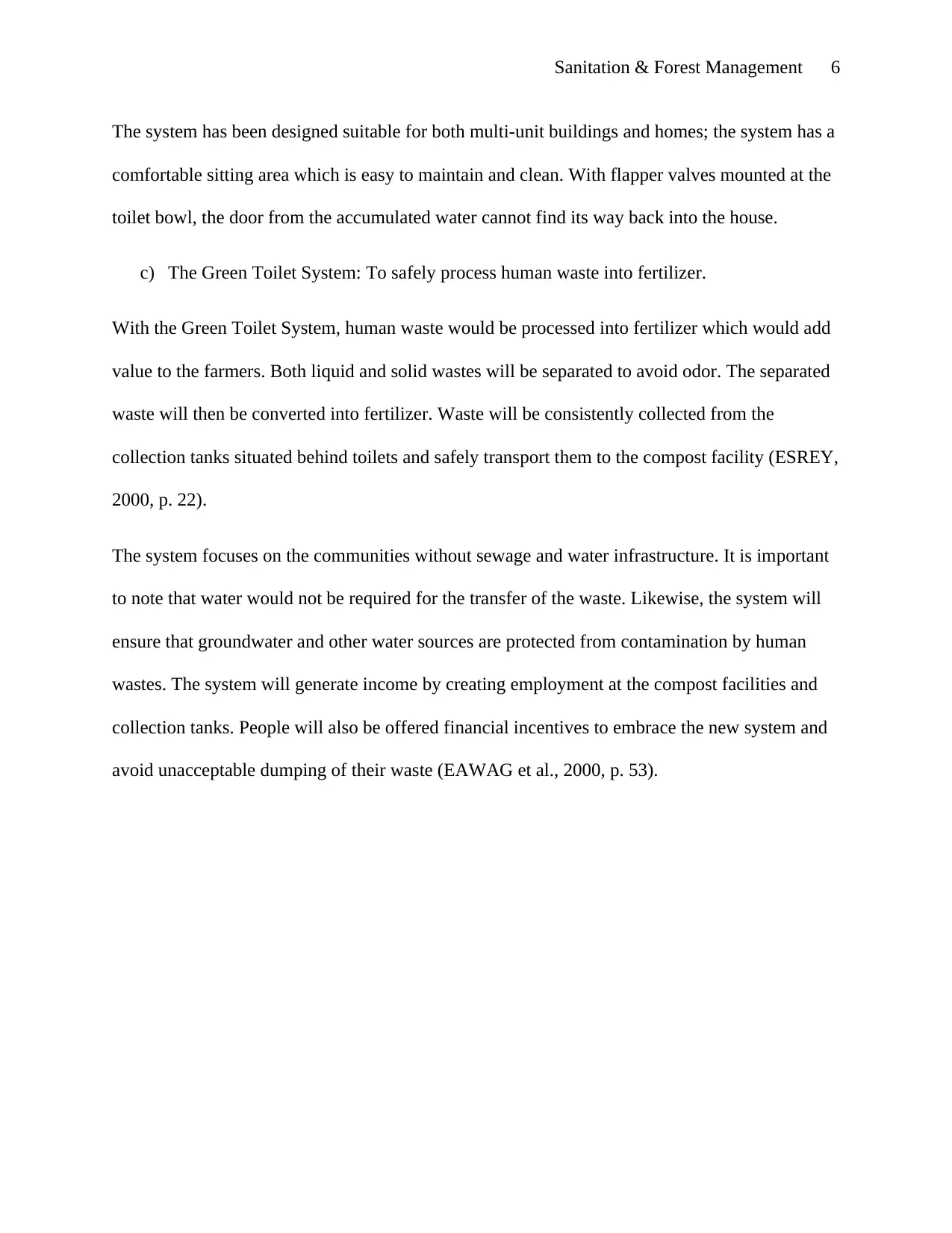
Sanitation & Forest Management 6
The system has been designed suitable for both multi-unit buildings and homes; the system has a
comfortable sitting area which is easy to maintain and clean. With flapper valves mounted at the
toilet bowl, the door from the accumulated water cannot find its way back into the house.
c) The Green Toilet System: To safely process human waste into fertilizer.
With the Green Toilet System, human waste would be processed into fertilizer which would add
value to the farmers. Both liquid and solid wastes will be separated to avoid odor. The separated
waste will then be converted into fertilizer. Waste will be consistently collected from the
collection tanks situated behind toilets and safely transport them to the compost facility (ESREY,
2000, p. 22).
The system focuses on the communities without sewage and water infrastructure. It is important
to note that water would not be required for the transfer of the waste. Likewise, the system will
ensure that groundwater and other water sources are protected from contamination by human
wastes. The system will generate income by creating employment at the compost facilities and
collection tanks. People will also be offered financial incentives to embrace the new system and
avoid unacceptable dumping of their waste (EAWAG et al., 2000, p. 53).
The system has been designed suitable for both multi-unit buildings and homes; the system has a
comfortable sitting area which is easy to maintain and clean. With flapper valves mounted at the
toilet bowl, the door from the accumulated water cannot find its way back into the house.
c) The Green Toilet System: To safely process human waste into fertilizer.
With the Green Toilet System, human waste would be processed into fertilizer which would add
value to the farmers. Both liquid and solid wastes will be separated to avoid odor. The separated
waste will then be converted into fertilizer. Waste will be consistently collected from the
collection tanks situated behind toilets and safely transport them to the compost facility (ESREY,
2000, p. 22).
The system focuses on the communities without sewage and water infrastructure. It is important
to note that water would not be required for the transfer of the waste. Likewise, the system will
ensure that groundwater and other water sources are protected from contamination by human
wastes. The system will generate income by creating employment at the compost facilities and
collection tanks. People will also be offered financial incentives to embrace the new system and
avoid unacceptable dumping of their waste (EAWAG et al., 2000, p. 53).
⊘ This is a preview!⊘
Do you want full access?
Subscribe today to unlock all pages.

Trusted by 1+ million students worldwide
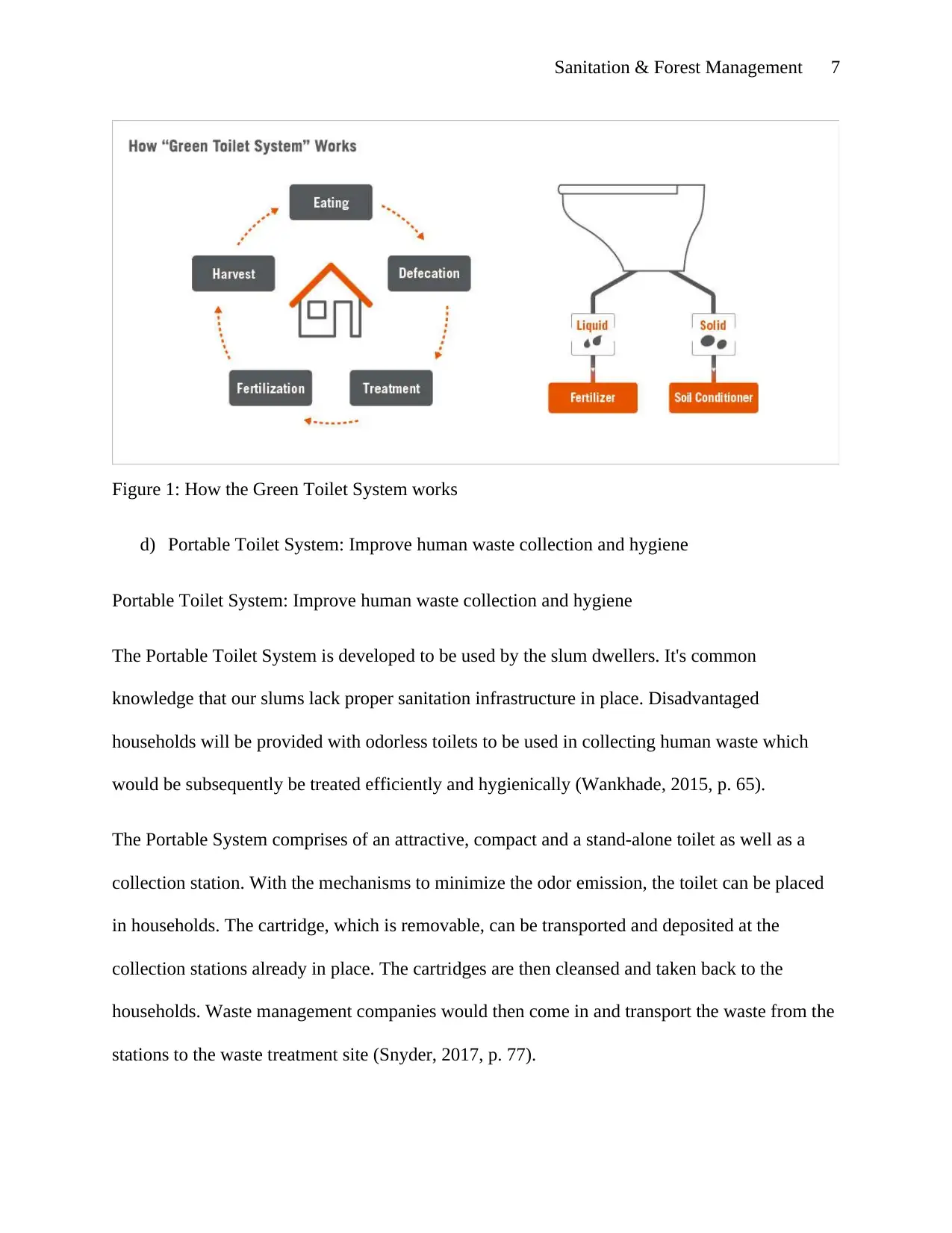
Sanitation & Forest Management 7
Figure 1: How the Green Toilet System works
d) Portable Toilet System: Improve human waste collection and hygiene
Portable Toilet System: Improve human waste collection and hygiene
The Portable Toilet System is developed to be used by the slum dwellers. It's common
knowledge that our slums lack proper sanitation infrastructure in place. Disadvantaged
households will be provided with odorless toilets to be used in collecting human waste which
would be subsequently be treated efficiently and hygienically (Wankhade, 2015, p. 65).
The Portable System comprises of an attractive, compact and a stand-alone toilet as well as a
collection station. With the mechanisms to minimize the odor emission, the toilet can be placed
in households. The cartridge, which is removable, can be transported and deposited at the
collection stations already in place. The cartridges are then cleansed and taken back to the
households. Waste management companies would then come in and transport the waste from the
stations to the waste treatment site (Snyder, 2017, p. 77).
Figure 1: How the Green Toilet System works
d) Portable Toilet System: Improve human waste collection and hygiene
Portable Toilet System: Improve human waste collection and hygiene
The Portable Toilet System is developed to be used by the slum dwellers. It's common
knowledge that our slums lack proper sanitation infrastructure in place. Disadvantaged
households will be provided with odorless toilets to be used in collecting human waste which
would be subsequently be treated efficiently and hygienically (Wankhade, 2015, p. 65).
The Portable System comprises of an attractive, compact and a stand-alone toilet as well as a
collection station. With the mechanisms to minimize the odor emission, the toilet can be placed
in households. The cartridge, which is removable, can be transported and deposited at the
collection stations already in place. The cartridges are then cleansed and taken back to the
households. Waste management companies would then come in and transport the waste from the
stations to the waste treatment site (Snyder, 2017, p. 77).
Paraphrase This Document
Need a fresh take? Get an instant paraphrase of this document with our AI Paraphraser
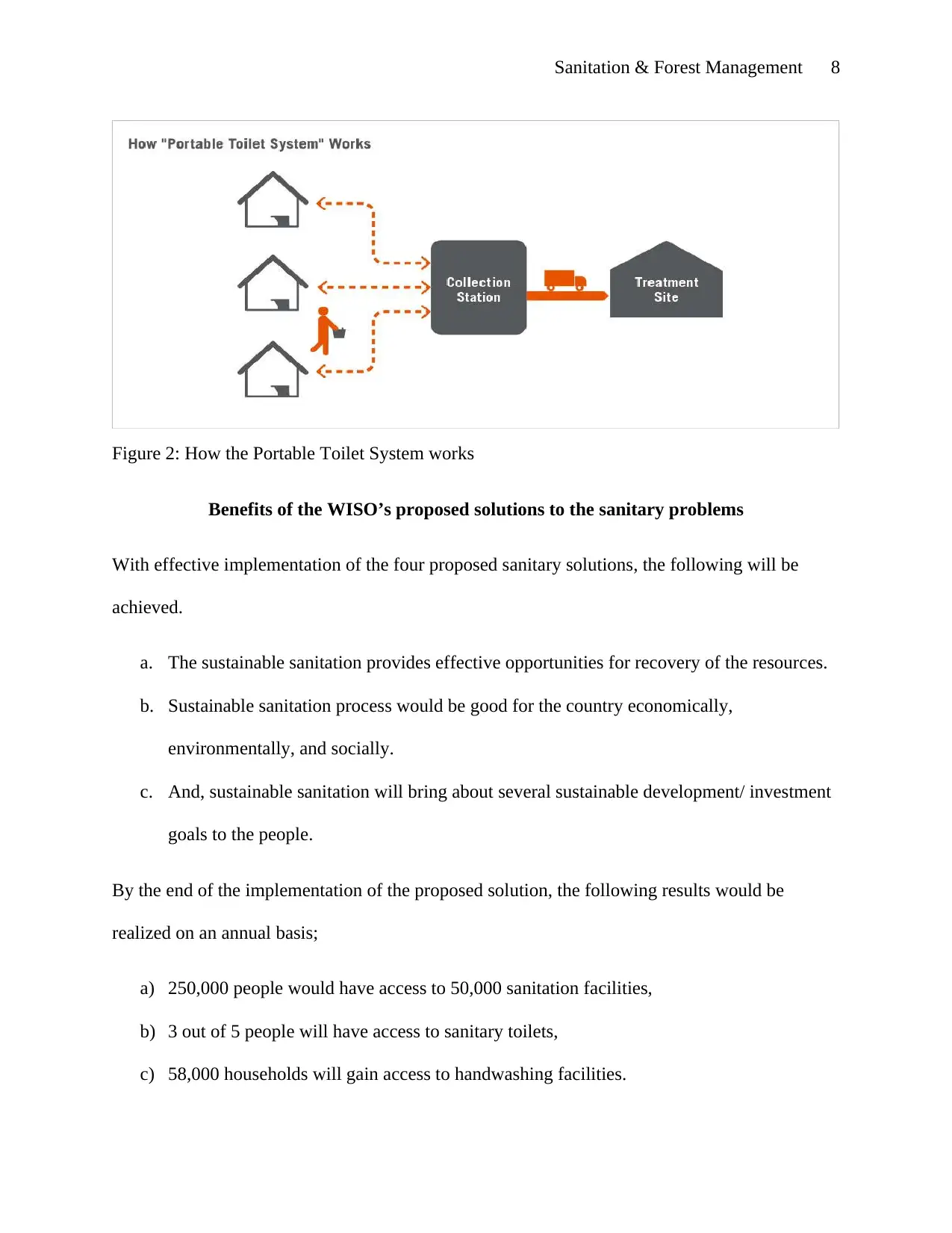
Sanitation & Forest Management 8
Figure 2: How the Portable Toilet System works
Benefits of the WISO’s proposed solutions to the sanitary problems
With effective implementation of the four proposed sanitary solutions, the following will be
achieved.
a. The sustainable sanitation provides effective opportunities for recovery of the resources.
b. Sustainable sanitation process would be good for the country economically,
environmentally, and socially.
c. And, sustainable sanitation will bring about several sustainable development/ investment
goals to the people.
By the end of the implementation of the proposed solution, the following results would be
realized on an annual basis;
a) 250,000 people would have access to 50,000 sanitation facilities,
b) 3 out of 5 people will have access to sanitary toilets,
c) 58,000 households will gain access to handwashing facilities.
Figure 2: How the Portable Toilet System works
Benefits of the WISO’s proposed solutions to the sanitary problems
With effective implementation of the four proposed sanitary solutions, the following will be
achieved.
a. The sustainable sanitation provides effective opportunities for recovery of the resources.
b. Sustainable sanitation process would be good for the country economically,
environmentally, and socially.
c. And, sustainable sanitation will bring about several sustainable development/ investment
goals to the people.
By the end of the implementation of the proposed solution, the following results would be
realized on an annual basis;
a) 250,000 people would have access to 50,000 sanitation facilities,
b) 3 out of 5 people will have access to sanitary toilets,
c) 58,000 households will gain access to handwashing facilities.
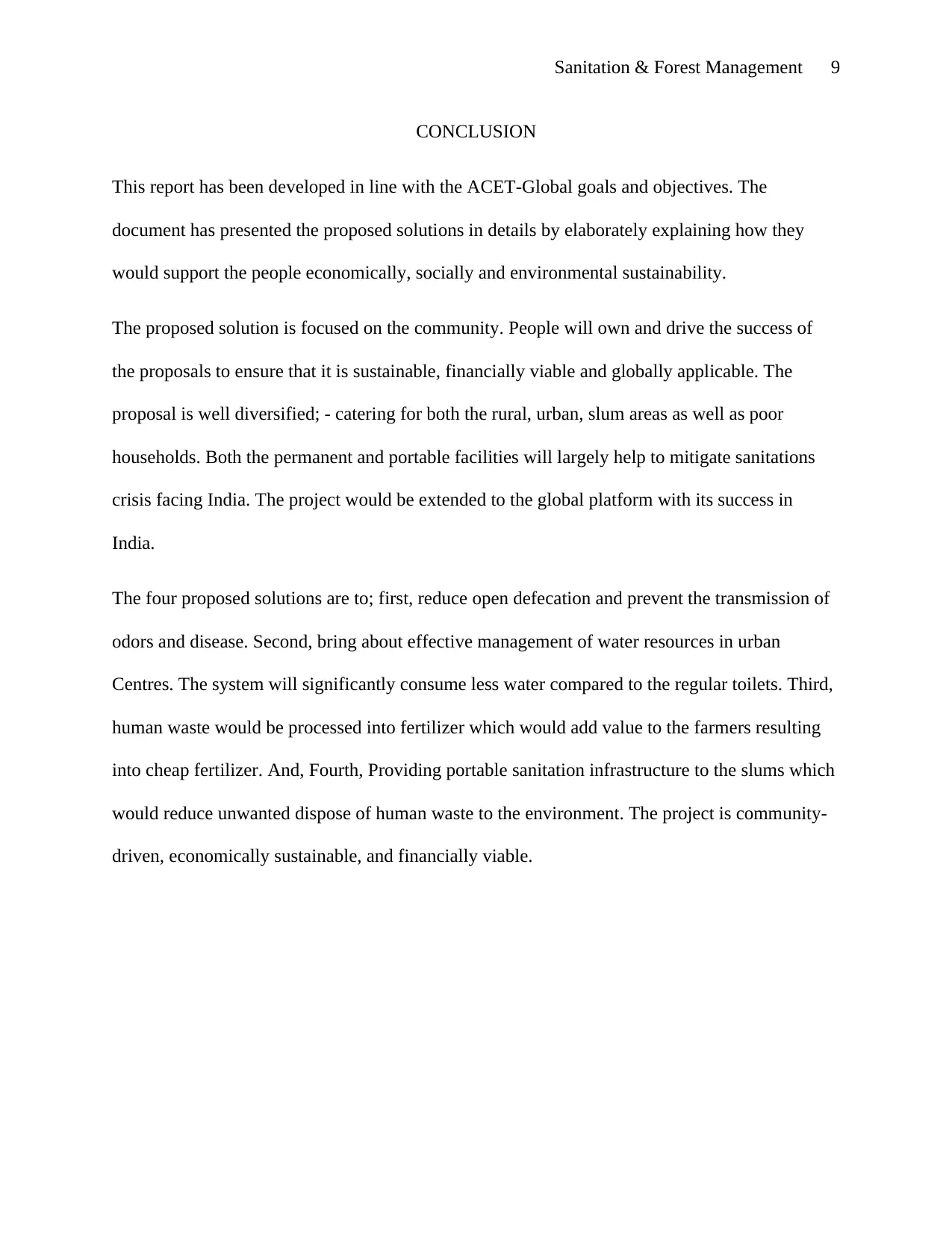
Sanitation & Forest Management 9
CONCLUSION
This report has been developed in line with the ACET-Global goals and objectives. The
document has presented the proposed solutions in details by elaborately explaining how they
would support the people economically, socially and environmental sustainability.
The proposed solution is focused on the community. People will own and drive the success of
the proposals to ensure that it is sustainable, financially viable and globally applicable. The
proposal is well diversified; - catering for both the rural, urban, slum areas as well as poor
households. Both the permanent and portable facilities will largely help to mitigate sanitations
crisis facing India. The project would be extended to the global platform with its success in
India.
The four proposed solutions are to; first, reduce open defecation and prevent the transmission of
odors and disease. Second, bring about effective management of water resources in urban
Centres. The system will significantly consume less water compared to the regular toilets. Third,
human waste would be processed into fertilizer which would add value to the farmers resulting
into cheap fertilizer. And, Fourth, Providing portable sanitation infrastructure to the slums which
would reduce unwanted dispose of human waste to the environment. The project is community-
driven, economically sustainable, and financially viable.
CONCLUSION
This report has been developed in line with the ACET-Global goals and objectives. The
document has presented the proposed solutions in details by elaborately explaining how they
would support the people economically, socially and environmental sustainability.
The proposed solution is focused on the community. People will own and drive the success of
the proposals to ensure that it is sustainable, financially viable and globally applicable. The
proposal is well diversified; - catering for both the rural, urban, slum areas as well as poor
households. Both the permanent and portable facilities will largely help to mitigate sanitations
crisis facing India. The project would be extended to the global platform with its success in
India.
The four proposed solutions are to; first, reduce open defecation and prevent the transmission of
odors and disease. Second, bring about effective management of water resources in urban
Centres. The system will significantly consume less water compared to the regular toilets. Third,
human waste would be processed into fertilizer which would add value to the farmers resulting
into cheap fertilizer. And, Fourth, Providing portable sanitation infrastructure to the slums which
would reduce unwanted dispose of human waste to the environment. The project is community-
driven, economically sustainable, and financially viable.
⊘ This is a preview!⊘
Do you want full access?
Subscribe today to unlock all pages.

Trusted by 1+ million students worldwide
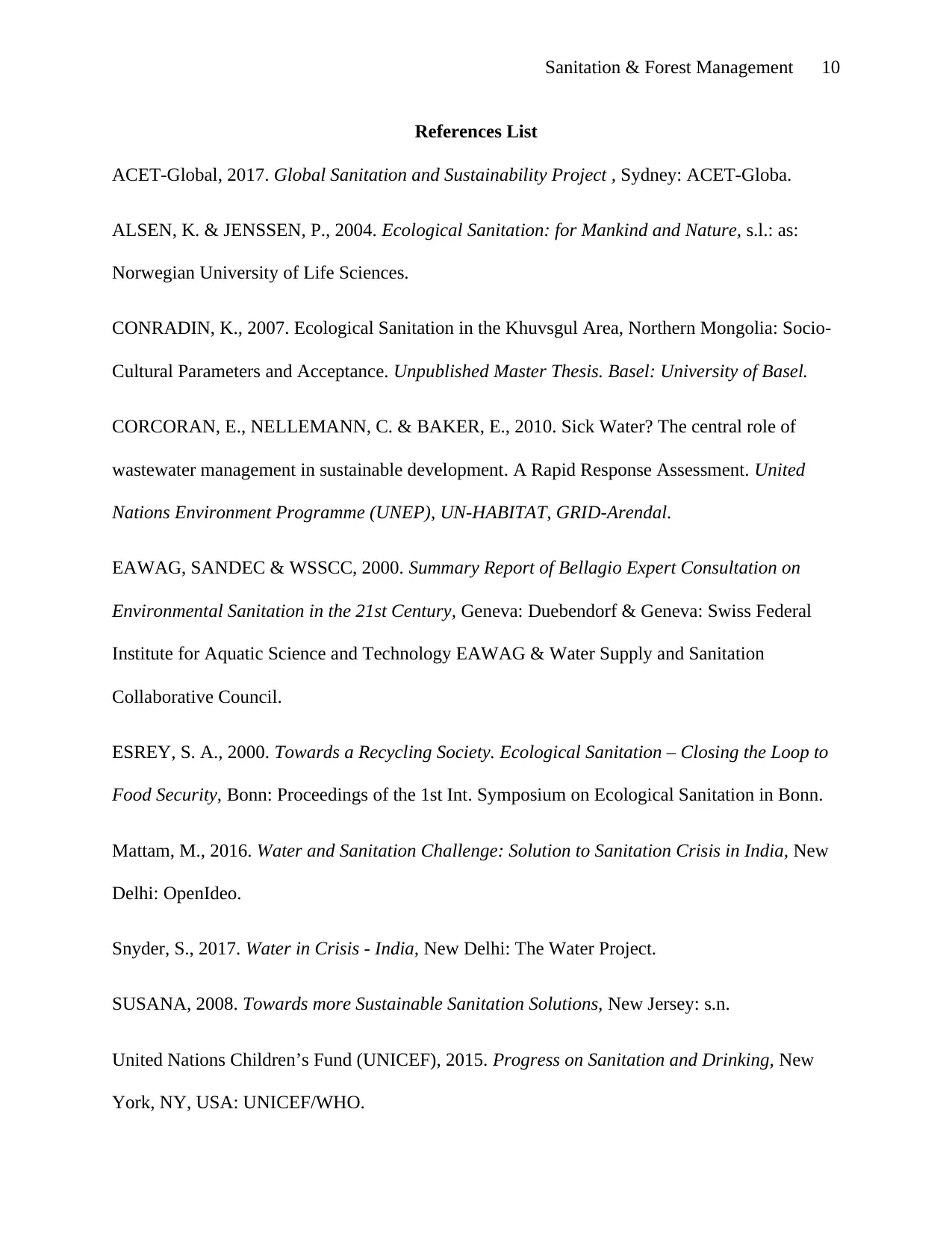
Sanitation & Forest Management 10
References List
ACET-Global, 2017. Global Sanitation and Sustainability Project , Sydney: ACET-Globa.
ALSEN, K. & JENSSEN, P., 2004. Ecological Sanitation: for Mankind and Nature, s.l.: as:
Norwegian University of Life Sciences.
CONRADIN, K., 2007. Ecological Sanitation in the Khuvsgul Area, Northern Mongolia: Socio-
Cultural Parameters and Acceptance. Unpublished Master Thesis. Basel: University of Basel.
CORCORAN, E., NELLEMANN, C. & BAKER, E., 2010. Sick Water? The central role of
wastewater management in sustainable development. A Rapid Response Assessment. United
Nations Environment Programme (UNEP), UN-HABITAT, GRID-Arendal.
EAWAG, SANDEC & WSSCC, 2000. Summary Report of Bellagio Expert Consultation on
Environmental Sanitation in the 21st Century, Geneva: Duebendorf & Geneva: Swiss Federal
Institute for Aquatic Science and Technology EAWAG & Water Supply and Sanitation
Collaborative Council.
ESREY, S. A., 2000. Towards a Recycling Society. Ecological Sanitation – Closing the Loop to
Food Security, Bonn: Proceedings of the 1st Int. Symposium on Ecological Sanitation in Bonn.
Mattam, M., 2016. Water and Sanitation Challenge: Solution to Sanitation Crisis in India, New
Delhi: OpenIdeo.
Snyder, S., 2017. Water in Crisis - India, New Delhi: The Water Project.
SUSANA, 2008. Towards more Sustainable Sanitation Solutions, New Jersey: s.n.
United Nations Children’s Fund (UNICEF), 2015. Progress on Sanitation and Drinking, New
York, NY, USA: UNICEF/WHO.
References List
ACET-Global, 2017. Global Sanitation and Sustainability Project , Sydney: ACET-Globa.
ALSEN, K. & JENSSEN, P., 2004. Ecological Sanitation: for Mankind and Nature, s.l.: as:
Norwegian University of Life Sciences.
CONRADIN, K., 2007. Ecological Sanitation in the Khuvsgul Area, Northern Mongolia: Socio-
Cultural Parameters and Acceptance. Unpublished Master Thesis. Basel: University of Basel.
CORCORAN, E., NELLEMANN, C. & BAKER, E., 2010. Sick Water? The central role of
wastewater management in sustainable development. A Rapid Response Assessment. United
Nations Environment Programme (UNEP), UN-HABITAT, GRID-Arendal.
EAWAG, SANDEC & WSSCC, 2000. Summary Report of Bellagio Expert Consultation on
Environmental Sanitation in the 21st Century, Geneva: Duebendorf & Geneva: Swiss Federal
Institute for Aquatic Science and Technology EAWAG & Water Supply and Sanitation
Collaborative Council.
ESREY, S. A., 2000. Towards a Recycling Society. Ecological Sanitation – Closing the Loop to
Food Security, Bonn: Proceedings of the 1st Int. Symposium on Ecological Sanitation in Bonn.
Mattam, M., 2016. Water and Sanitation Challenge: Solution to Sanitation Crisis in India, New
Delhi: OpenIdeo.
Snyder, S., 2017. Water in Crisis - India, New Delhi: The Water Project.
SUSANA, 2008. Towards more Sustainable Sanitation Solutions, New Jersey: s.n.
United Nations Children’s Fund (UNICEF), 2015. Progress on Sanitation and Drinking, New
York, NY, USA: UNICEF/WHO.
Paraphrase This Document
Need a fresh take? Get an instant paraphrase of this document with our AI Paraphraser
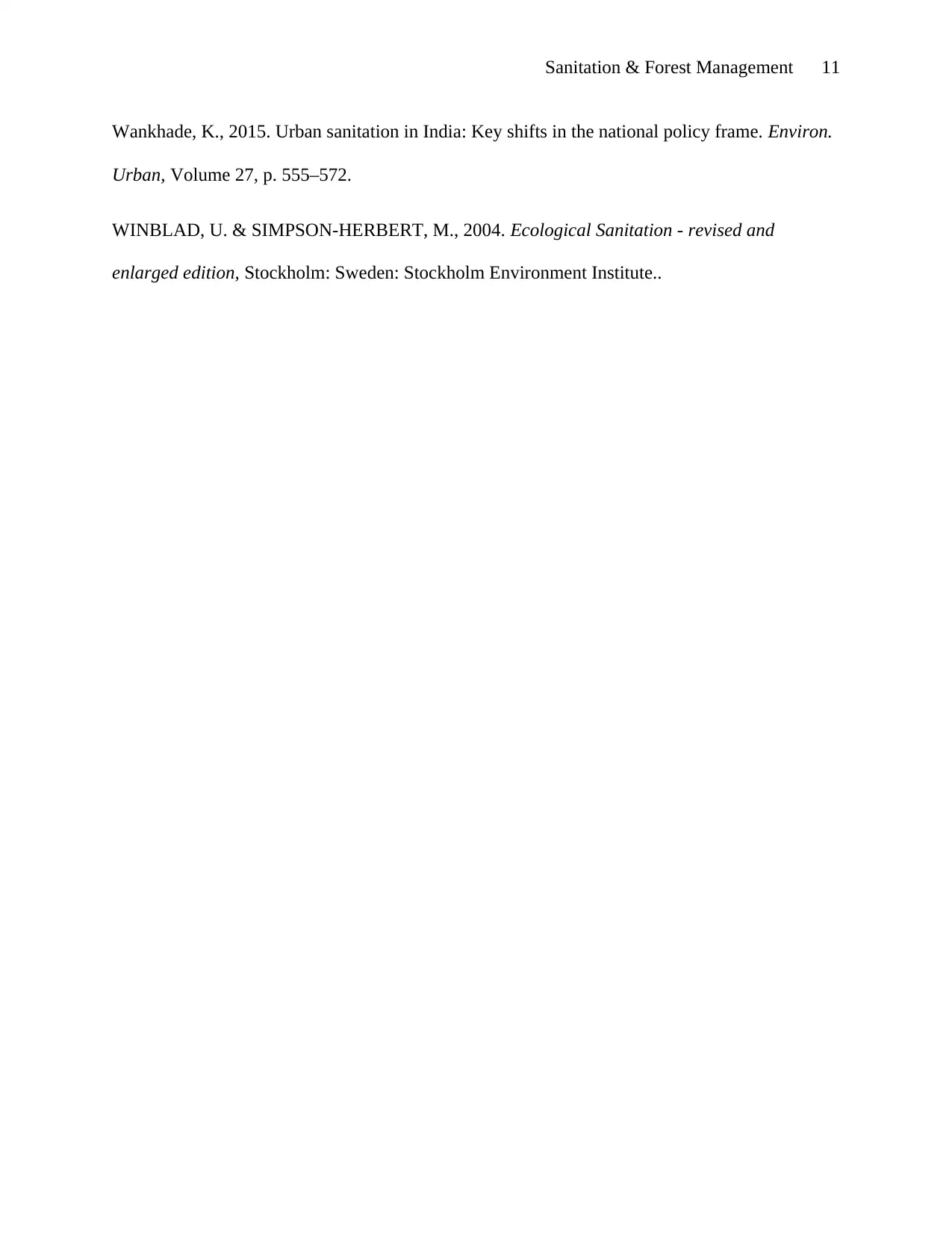
Sanitation & Forest Management 11
Wankhade, K., 2015. Urban sanitation in India: Key shifts in the national policy frame. Environ.
Urban, Volume 27, p. 555–572.
WINBLAD, U. & SIMPSON-HERBERT, M., 2004. Ecological Sanitation - revised and
enlarged edition, Stockholm: Sweden: Stockholm Environment Institute..
Wankhade, K., 2015. Urban sanitation in India: Key shifts in the national policy frame. Environ.
Urban, Volume 27, p. 555–572.
WINBLAD, U. & SIMPSON-HERBERT, M., 2004. Ecological Sanitation - revised and
enlarged edition, Stockholm: Sweden: Stockholm Environment Institute..
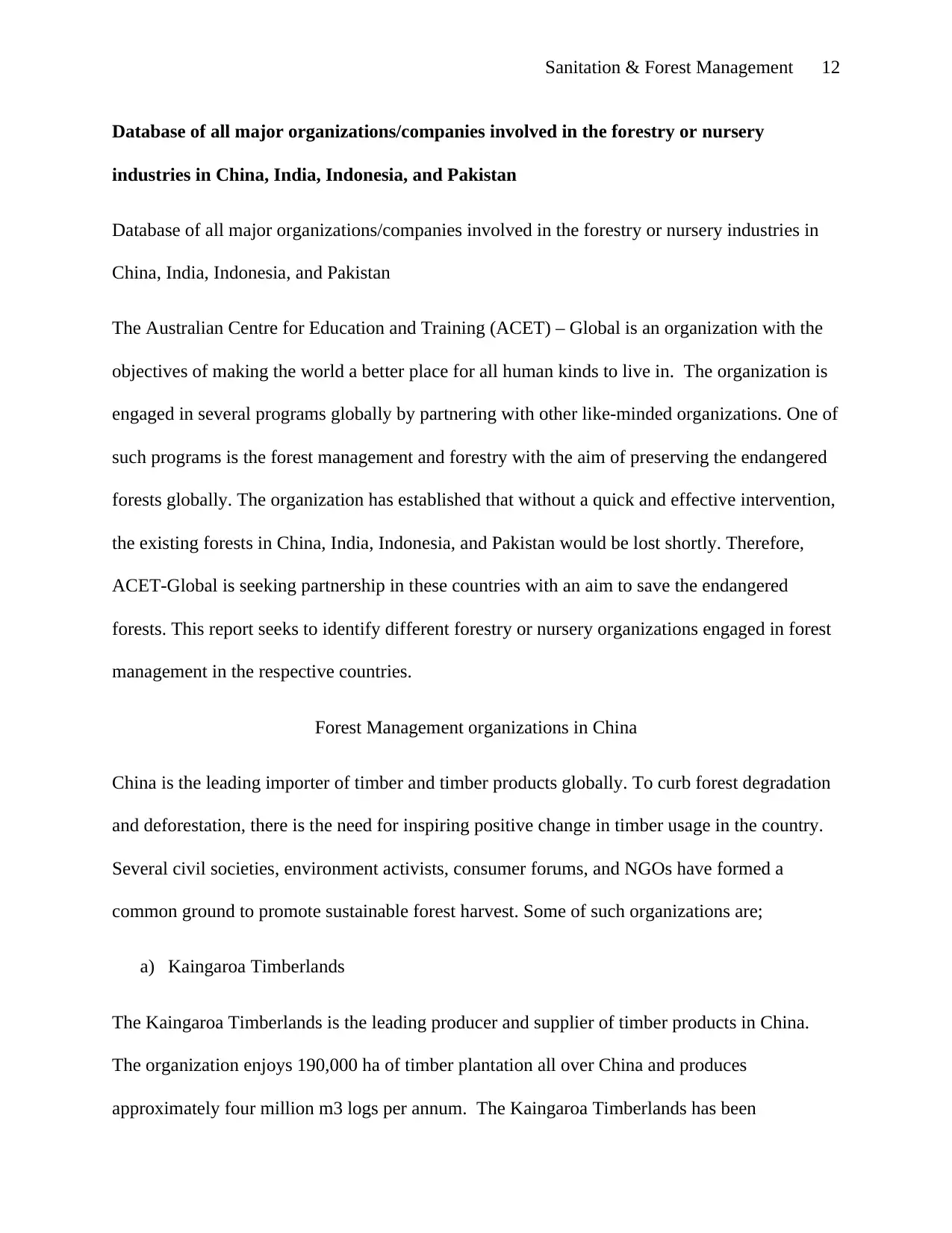
Sanitation & Forest Management 12
Database of all major organizations/companies involved in the forestry or nursery
industries in China, India, Indonesia, and Pakistan
Database of all major organizations/companies involved in the forestry or nursery industries in
China, India, Indonesia, and Pakistan
The Australian Centre for Education and Training (ACET) – Global is an organization with the
objectives of making the world a better place for all human kinds to live in. The organization is
engaged in several programs globally by partnering with other like-minded organizations. One of
such programs is the forest management and forestry with the aim of preserving the endangered
forests globally. The organization has established that without a quick and effective intervention,
the existing forests in China, India, Indonesia, and Pakistan would be lost shortly. Therefore,
ACET-Global is seeking partnership in these countries with an aim to save the endangered
forests. This report seeks to identify different forestry or nursery organizations engaged in forest
management in the respective countries.
Forest Management organizations in China
China is the leading importer of timber and timber products globally. To curb forest degradation
and deforestation, there is the need for inspiring positive change in timber usage in the country.
Several civil societies, environment activists, consumer forums, and NGOs have formed a
common ground to promote sustainable forest harvest. Some of such organizations are;
a) Kaingaroa Timberlands
The Kaingaroa Timberlands is the leading producer and supplier of timber products in China.
The organization enjoys 190,000 ha of timber plantation all over China and produces
approximately four million m3 logs per annum. The Kaingaroa Timberlands has been
Database of all major organizations/companies involved in the forestry or nursery
industries in China, India, Indonesia, and Pakistan
Database of all major organizations/companies involved in the forestry or nursery industries in
China, India, Indonesia, and Pakistan
The Australian Centre for Education and Training (ACET) – Global is an organization with the
objectives of making the world a better place for all human kinds to live in. The organization is
engaged in several programs globally by partnering with other like-minded organizations. One of
such programs is the forest management and forestry with the aim of preserving the endangered
forests globally. The organization has established that without a quick and effective intervention,
the existing forests in China, India, Indonesia, and Pakistan would be lost shortly. Therefore,
ACET-Global is seeking partnership in these countries with an aim to save the endangered
forests. This report seeks to identify different forestry or nursery organizations engaged in forest
management in the respective countries.
Forest Management organizations in China
China is the leading importer of timber and timber products globally. To curb forest degradation
and deforestation, there is the need for inspiring positive change in timber usage in the country.
Several civil societies, environment activists, consumer forums, and NGOs have formed a
common ground to promote sustainable forest harvest. Some of such organizations are;
a) Kaingaroa Timberlands
The Kaingaroa Timberlands is the leading producer and supplier of timber products in China.
The organization enjoys 190,000 ha of timber plantation all over China and produces
approximately four million m3 logs per annum. The Kaingaroa Timberlands has been
⊘ This is a preview!⊘
Do you want full access?
Subscribe today to unlock all pages.

Trusted by 1+ million students worldwide
1 out of 16
Your All-in-One AI-Powered Toolkit for Academic Success.
+13062052269
info@desklib.com
Available 24*7 on WhatsApp / Email
![[object Object]](/_next/static/media/star-bottom.7253800d.svg)
Unlock your academic potential
Copyright © 2020–2025 A2Z Services. All Rights Reserved. Developed and managed by ZUCOL.